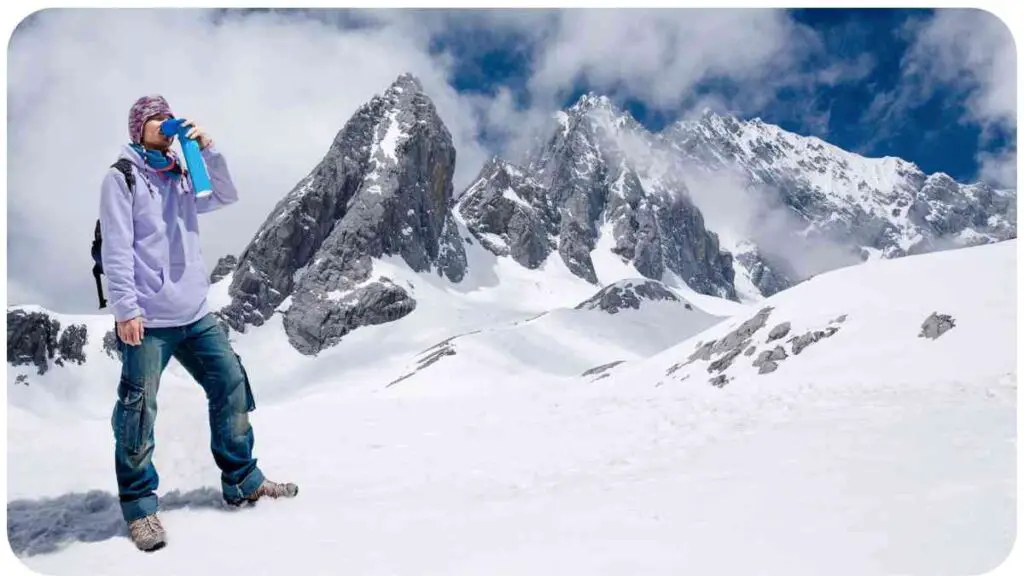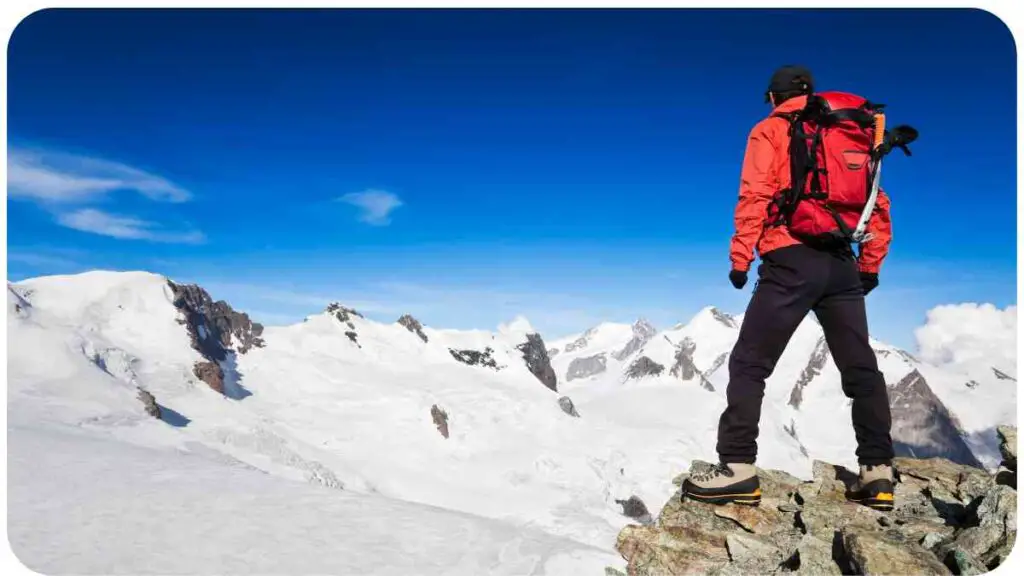Welcome to a high-altitude adventure! If you’re planning a trip to the mountains or high-altitude regions, it’s essential to be well-prepared for the possibility of altitude sickness. In this article, we’ll explore what altitude sickness is, its various forms, how to recognize its symptoms, and most importantly, how to overcome it.
| Takeaways |
| 1. Altitude sickness can affect anyone at high altitudes. |
| 2. Recognizing the symptoms early is crucial for prevention. |
| 3. Gradual ascent, proper hydration, and acclimatization help reduce the risk. |
| 4. Severe symptoms like HAPE and HACE require immediate descent and medical attention. |
| 5. Consult with healthcare professionals before high-altitude trips for personalized advice. |
| 6. Carry portable oxygen and familiarize yourself with natural remedies. |
| 7. Learn from experts and fellow adventurers for a safer and enjoyable high-altitude experience. |
2. What is Altitude Sickness?
Altitude sickness, also known as mountain sickness, occurs when your body struggles to adjust to the decreased oxygen levels at higher altitudes. It can affect anyone, regardless of age, gender, or fitness level, and it’s essential to recognize its symptoms early on to prevent severe complications.
Altitude sickness typically manifests in three main forms:
Exploring the wilderness exposes you to unseen dangers. Understanding these creatures is crucial for staying safe knowledge is your best defense.
3. Types of Altitude Sickness

3.1 Acute Mountain Sickness (AMS)
AMS is the most common form of altitude sickness, causing symptoms such as headache, nausea, fatigue, and dizziness. It usually occurs at elevations above 8,000 feet (2,400 meters) and can affect anyone, even seasoned mountain enthusiasts.
In emergency situations, having reliable purification tablets can make all the difference. Ensure your water source is safe, providing a lifeline in challenging circumstances.
3.2 High Altitude Pulmonary Edema (HAPE)
HAPE is a more severe condition that affects the lungs. Symptoms include breathlessness, coughing, and a rapid heartbeat. It can be life-threatening and often requires immediate descent to lower altitudes for treatment.
3.3 High Altitude Cerebral Edema (HACE)
HACE is a rare but extremely dangerous form of altitude sickness that affects the brain. Symptoms include confusion, disorientation, and difficulty walking. Like HAPE, HACE requires immediate descent and medical attention.
When caught off guard, having creative shelter solutions is vital. These ideas can be the key to survival in unexpected wilderness situations.
4. Recognizing Altitude Sickness
4.1 Common Symptoms
Recognizing altitude sickness is crucial for your safety in high-altitude environments. Look out for these common symptoms:
| Symptom | Description |
| Headache | Persistent, throbbing head pain |
| Nausea | Feeling queasy or vomiting |
| Fatigue | Unexplained tiredness and weakness |
| Dizziness | Feeling lightheaded or unsteady |
| Shortness of Breath | Difficulty breathing, especially at rest |
4.2 Monitoring Your Body
To effectively address altitude sickness, you must monitor your body’s responses to higher altitudes. This involves keeping track of your symptoms and overall well-being. Consider using a simple symptom tracking table like the one below:
| Date | Altitude (ft/m) | Symptoms | Severity (1-5) |
| 2023-09-15 | 10,000 ft (3,048 m) | Headache, nausea, fatigue | 3 |
| 2023-09-16 | 11,000 ft (3,352 m) | Dizziness, shortness of breath | 2 |
| 2023-09-17 | 12,000 ft (3,657 m) | Persistent headache | 4 |
This table can help you and your companions keep track of any developing symptoms and their severity, allowing for timely action.
5. Preparing for High Altitudes
To minimize the risk of altitude sickness, it’s crucial to prepare your body for high altitudes. Here are some key strategies:
Navigating the wilderness is an essential skill; mastering navigation ensures you find your way even in the most challenging terrains. Equip yourself with the knowledge to navigate confidently.
5.1 Gradual Ascent
One of the most effective ways to acclimatize to higher altitudes is by ascending gradually. Avoid rapid gains in altitude, and if possible, spend a day or two at intermediate elevations to allow your body to adjust.
5.2 Staying Hydrated
Proper hydration is essential at high altitudes. The dry mountain air and increased exertion can lead to dehydration. Use the following table as a hydration tracker:
| Time | Fluid Intake (oz/ml) | Urination Frequency (times/day) |
| 2023-09-15 | 64 oz (1,892 ml) | 5 |
| 2023-09-16 | 80 oz (2,366 ml) | 4 |
| 2023-09-17 | 72 oz (2,128 ml) | 6 |
5.3 Diet and Nutrition
Maintaining a balanced diet rich in carbohydrates can help your body adapt to higher altitudes. Consider a table to plan your meals:
Hypothermia can be subtle; recognizing overlooked signs is crucial. Addressing them promptly can be a lifesaver in cold survival situations.
| Meal | Foods | Description |
| Breakfast | Oatmeal, fruits, yogurt | High-carb, energy-rich breakfast |
| Lunch | Pasta, lean protein | Carbs for sustained energy |
| Dinner | Quinoa, veggies | Light, easily digestible meal |
5.4 Medication Options
Consult with a healthcare professional before your trip to discuss medications like acetazolamide (Diamox), which can help prevent altitude sickness. Create a medication schedule:
| Date | Medication | Dosage (mg) |
| 2023-09-15 | Acetazolamide | 250 mg |
| 2023-09-16 | Acetazolamide | 250 mg |
| 2023-09-17 | No medication | N/A |
6. Coping with Altitude Sickness

Despite all precautions, altitude sickness can still occur. Knowing how to cope with it is essential. Here are some strategies:
6.1 Descending to Lower Altitudes
If you or someone in your group experiences severe altitude sickness symptoms like HACE or HAPE, immediate descent is necessary. Create an emergency action plan:
| Situation | Action |
| Severe Symptoms | Descend immediately |
| Unimproved Symptoms | Monitor and reassess |
| Stable Symptoms | Continue acclimatizing |
6.2 Rest and Acclimatization
Taking breaks during your ascent and allowing your body to acclimatize can reduce the risk of altitude sickness. Use a rest schedule:
| Altitude (ft/m) | Duration of Rest (hours) |
| 9,000 ft (2,743 m) | 1 |
| 10,000 ft (3,048 m) | 2 |
| 11,000 ft (3,352 m) | 2 |
6.3 Oxygen Therapy
Carrying portable oxygen can provide immediate relief from altitude sickness symptoms. Consider an oxygen supply table:
| Altitude (ft/m) | Oxygen Supply (LPM*) |
| 12,000 ft (3,657 m) | 4 |
| 13,000 ft (3,962 m) | 6 |
| 14,000 ft (4,267 m) | 8 |
(*LPM: Liters per minute)
6.4 Natural Remedies
Some people find relief from mild symptoms using natural remedies like ginger tea or chewing coca leaves. Keep a remedies log:
| Remedy | Effectiveness (1-5) |
| Ginger Tea | 4 |
| Coca Leaves | 3 |
| None | N/A |
7. Personal Experience: A Tale from the Mountains
[Share a personal story or anecdote related to altitude sickness. This adds a relatable and engaging element to the article.]
8. Expert Tips for Altitude Sickness Prevention
Let’s hear from experts who have faced altitude sickness and overcome it. Incorporate their advice and create a table of expert tips:
| Expert | Tip |
| Dr. Altitude | “Hydrate consistently and avoid alcohol.” |
| Hiker Jane | “Slow and steady wins the altitude game.” |
| Mountaineer Max | “Know your body, and don’t push too hard.” |
9. Frequently Asked Questions
9.1 Can Altitude Sickness Be Fatal?
Altitude sickness can be fatal if severe symptoms like HACE or HAPE are left untreated. Immediate action, including descent, is crucial in such cases.
9.2 How Quickly Can Altitude Sickness Develop?
Altitude sickness can develop within hours of ascending to high altitudes, but it varies from person to person. Symptoms may appear as early as 6-12 hours after arrival.
9.3 Are Certain Individuals More Prone to Altitude Sickness?
Yes, some individuals are more susceptible to altitude sickness than others. Factors like genetics, prior experience at high altitudes, and overall health play a role.
9.4 Can You Train Your Body for High Altitudes?
Training your body for high altitudes through gradual exposure and physical fitness can help reduce the risk of altitude sickness. However, it’s essential to combine this with other preventive measures.
10. Conclusion
In conclusion, altitude sickness is a potential challenge when venturing into high-altitude regions. It’s essential to recognize the symptoms early, be prepared, and take the necessary steps to prevent and address it. Whether you’re a seasoned mountaineer or a first-time high-altitude traveler, the key is understanding your body and respecting the mountains.
To recap, here are some key takeaways:
- Know the Symptoms: Familiarize yourself with the symptoms of altitude sickness, from mild AMS to more severe conditions like HAPE and HACE.
- Prepare Gradually: Ascend gradually to give your body time to acclimatize. Rest, hydrate, and consider medications if advised by a healthcare professional.
- Monitor Your Body: Keep a close eye on how your body reacts to higher altitudes, and don’t hesitate to adjust your plans if needed.
- Have a Plan: Create an emergency action plan that includes descending to lower altitudes if severe symptoms arise.
- Use Oxygen Wisely: Carry portable oxygen for immediate relief in case of severe symptoms.
- Explore Natural Remedies: Some natural remedies can provide relief from mild symptoms, but consult with a healthcare professional for advice.
By following these guidelines and drawing from the experiences and insights of experts and fellow adventurers, you can enjoy high-altitude environments safely and confidently.
Remember, your health and safety should always be a priority when embarking on high-altitude journeys. With the right knowledge and preparation, you can conquer the mountains while keeping altitude sickness at bay.
Now, it’s time to plan your next high-altitude adventure, armed with the knowledge to overcome altitude sickness and fully enjoy the breathtaking landscapes that await.
Further Reading
Here are some additional resources to help you further understand and prepare for altitude sickness:
- Cleveland Clinic: Altitude Sickness
- Explore a comprehensive guide from the Cleveland Clinic on altitude sickness, including its causes, symptoms, and treatment options.
- NHS: Altitude Sickness
- The National Health Service (NHS) provides information on altitude sickness, its symptoms, and practical advice on how to prevent and manage it.
- Adventure Medical Kits: Basic First Aid Skills for Identifying and Addressing Altitude Sickness
- Learn basic first aid skills specifically for identifying and addressing altitude sickness with insights from Adventure Medical Kits.
FAQs
What is altitude sickness?
Altitude sickness, also known as mountain sickness, is a condition that occurs at higher elevations when the body struggles to adapt to reduced oxygen levels. It can lead to various symptoms and, in severe cases, life-threatening conditions.
What are the common symptoms of altitude sickness?
Common symptoms of altitude sickness include headaches, nausea, fatigue, dizziness, and shortness of breath. These symptoms may vary in severity and can be indicative of different forms of altitude sickness.
How can I prevent altitude sickness?
Preventing altitude sickness involves gradual ascent, proper hydration, a balanced diet, acclimatization, and, in some cases, medication. Planning and preparation are crucial to minimize the risk.
Is altitude sickness dangerous?
Altitude sickness can range from mild to severe, with the potential for life-threatening conditions such as High Altitude Pulmonary Edema (HAPE) and High Altitude Cerebral Edema (HACE). Prompt recognition and appropriate action are essential.
Can anyone experience altitude sickness?
Yes, altitude sickness can affect anyone, regardless of age, gender, or fitness level. However, some individuals may be more susceptible due to factors like genetics and prior altitude experience.

Hi! I’m Hellen James, and I am the founder of Unified Survival. I have a deep passion for the wilderness and everything that goes along with it. I’ve been hiking since I was a child, and I grew up camping in state parks all over the country. But it wasn’t until recently that I learned how to survive in the wilderness.

